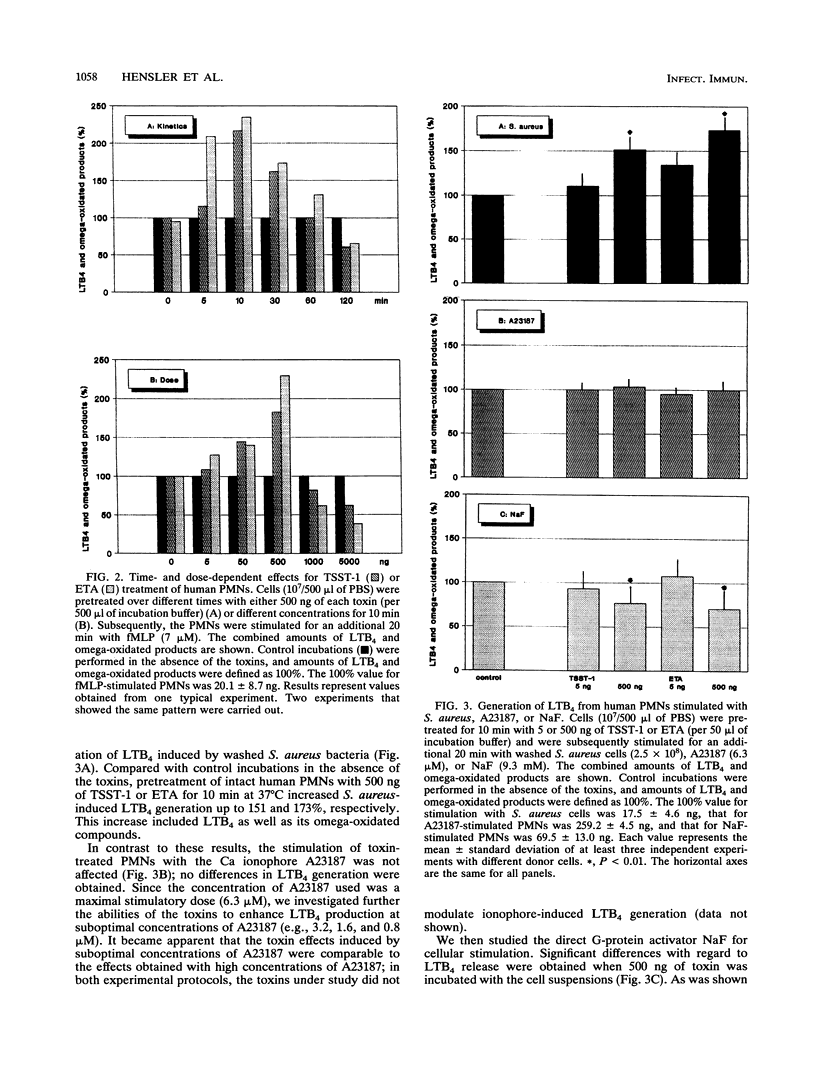Abstract
We studied the influence of staphylococcal toxic shock syndrome toxin 1 and streptococcal erythrogenic (pyrogenic) toxin A (ETA) on intact and digitonin-permeabilized human polymorphonuclear granulocytes (PMNs). As was shown by reversed-phase high-performance liquid chromatography analysis, toxic shock syndrome toxin 1 or ETA alone, in the absence of any additional stimulus, did not induce the generation of the chemoattractant leukotriene B4 (LTB4) from PMNs in a wide range of concentrations. In addition, pretreatment of intact PMNs with either toxin potentiated formyl-methionyl-leucyl-phenylalanine (fMLP)- and washed Staphylococcus aureus cell-induced generation of LTB4 in a time- and dose-dependent manner. This increase included LTB4 as well as its inactive omega-oxidated compounds. Further studies revealed evidence that toxin exposure was accompanied by enhanced cellular receptor expression for fMLP as well as for LTB4. The intrinsic GTPase activity of membrane fractions was modulated by both toxins. Short-term incubation with ETA increased the GTPase activity of PMNs up to 141%. Inhibitory effects were obtained when GTP-binding protein functions were stimulated with sodium fluoride (NaF). In addition, specific binding of Gpp(NH)p to GTP-binding protein was inhibited by both toxins during the first 10 min of incubation and was restored at later times of incubation. Our data therefore suggest that both toxins significantly affect the signal transduction pathways of human PMNs, which results in immunomodulatory functions.
Full text
PDF






Selected References
These references are in PubMed. This may not be the complete list of references from this article.
- Ando M., Furui H., Suzuki K., Taki F., Takagi K. Direct activation of phospholipase A2 by GTP-binding protein in human peripheral polymorphonuclear leukocytes. Biochem Biophys Res Commun. 1992 Mar 16;183(2):708–713. doi: 10.1016/0006-291x(92)90540-2. [DOI] [PubMed] [Google Scholar]
- Becker E. L., Kanaho Y., Kermode J. C. Nature and functioning of the pertussis toxin-sensitive G protein of neutrophils. Biomed Pharmacother. 1987;41(6):289–297. [PubMed] [Google Scholar]
- Bray M. A. Leukotrienes in inflammation. Agents Actions. 1986 Oct;19(1-2):87–99. doi: 10.1007/BF01977263. [DOI] [PubMed] [Google Scholar]
- Bremm K. D., König W., Pfeiffer P., Rauschen I., Theobald K., Thelestam M., Alouf J. E. Effect of thiol-activated toxins (streptolysin O, alveolysin, and theta toxin) on the generation of leukotrienes and leukotriene-inducing and -metabolizing enzymes from human polymorphonuclear granulocytes. Infect Immun. 1985 Dec;50(3):844–851. doi: 10.1128/iai.50.3.844-851.1985. [DOI] [PMC free article] [PubMed] [Google Scholar]
- Brom J., Schönfeld W., König W. Metabolism of leukotriene B4 by activated human polymorphonuclear granulocytes. Immunology. 1988 Jul;64(3):509–518. [PMC free article] [PubMed] [Google Scholar]
- Böyum A. Isolation of mononuclear cells and granulocytes from human blood. Isolation of monuclear cells by one centrifugation, and of granulocytes by combining centrifugation and sedimentation at 1 g. Scand J Clin Lab Invest Suppl. 1968;97:77–89. [PubMed] [Google Scholar]
- Fleischer B., Gerardy-Schahn R., Metzroth B., Carrel S., Gerlach D., Köhler W. An evolutionary conserved mechanism of T cell activation by microbial toxins. Evidence for different affinities of T cell receptor-toxin interaction. J Immunol. 1991 Jan 1;146(1):11–17. [PubMed] [Google Scholar]
- Gilman A. G. G proteins: transducers of receptor-generated signals. Annu Rev Biochem. 1987;56:615–649. doi: 10.1146/annurev.bi.56.070187.003151. [DOI] [PubMed] [Google Scholar]
- Hansson G., Lindgren J. A., Dahlén S. E., Hedqvist P., Samuelsson B. Identification and biological activity of novel omega-oxidized metabolites of leukotriene B4 from human leukocytes. FEBS Lett. 1981 Jul 20;130(1):107–112. doi: 10.1016/0014-5793(81)80676-x. [DOI] [PubMed] [Google Scholar]
- Hensler T., Köller M., Alouf J. E., König W. Bacterial toxins induce heat shock proteins in human neutrophils. Biochem Biophys Res Commun. 1991 Sep 16;179(2):872–879. doi: 10.1016/0006-291x(91)91899-n. [DOI] [PubMed] [Google Scholar]
- Hensler T., Köller M., König W. Regulation of leukotriene B4 generation from human polymorphonuclear granulocytes after stimulation with formyl-methionyl-leucyl phenylalanine: effects of pertussis and cholera toxins. Infect Immun. 1991 Sep;59(9):3046–3052. doi: 10.1128/iai.59.9.3046-3052.1991. [DOI] [PMC free article] [PubMed] [Google Scholar]
- Köller M., König W., Brom J., Erbs G., Müller F. E. Studies on the mechanisms of granulocyte dysfunctions in severely burned patients--evidence for altered leukotriene generation. J Trauma. 1989 Apr;29(4):435–445. doi: 10.1097/00005373-198904000-00004. [DOI] [PubMed] [Google Scholar]
- König W., Schönfeld W., Raulf M., Köller M., Knöller J., Scheffer J., Brom J. The neutrophil and leukotrienes--role in health and disease. Eicosanoids. 1990;3(1):1–22. [PubMed] [Google Scholar]
- LOWRY O. H., ROSEBROUGH N. J., FARR A. L., RANDALL R. J. Protein measurement with the Folin phenol reagent. J Biol Chem. 1951 Nov;193(1):265–275. [PubMed] [Google Scholar]
- Matsumoto T., Molski T. F., Kanaho Y., Becker E. L., Sha'afi R. I. G-protein dissociation, GTP-GDP exchange and GTPase activity in control and PMA treated neutrophils stimulated by fMet-Leu-Phe. Biochem Biophys Res Commun. 1987 Mar 13;143(2):489–498. doi: 10.1016/0006-291x(87)91380-5. [DOI] [PubMed] [Google Scholar]
- McDonald P. P., McColl S. R., Naccache P. H., Borgeat P. Activation of the human neutrophil 5-lipoxygenase by leukotriene B4. Br J Pharmacol. 1992 Sep;107(1):226–232. doi: 10.1111/j.1476-5381.1992.tb14491.x. [DOI] [PMC free article] [PubMed] [Google Scholar]
- Musser J. M., Hauser A. R., Kim M. H., Schlievert P. M., Nelson K., Selander R. K. Streptococcus pyogenes causing toxic-shock-like syndrome and other invasive diseases: clonal diversity and pyrogenic exotoxin expression. Proc Natl Acad Sci U S A. 1991 Apr 1;88(7):2668–2672. doi: 10.1073/pnas.88.7.2668. [DOI] [PMC free article] [PubMed] [Google Scholar]
- Prentki M., Wollheim C. B., Lew P. D. Ca2+ homeostasis in permeabilized human neutrophils. Characterization of Ca2+-sequestering pools and the action of inositol 1,4,5-triphosphate. J Biol Chem. 1984 Nov 25;259(22):13777–13782. [PubMed] [Google Scholar]
- Salari H., Braquet P., Naccache P., Borgeat P. Characterization of effect of N-formyl-methionyl-leucyl-phenylalanine on leukotriene synthesis in human polymorphonuclear leukocytes. Inflammation. 1985 Jun;9(2):127–138. doi: 10.1007/BF00917585. [DOI] [PubMed] [Google Scholar]
- Scheffer J., König W., Braun V., Goebel W. Comparison of four hemolysin-producing organisms (Escherichia coli, Serratia marcescens, Aeromonas hydrophila, and Listeria monocytogenes) for release of inflammatory mediators from various cells. J Clin Microbiol. 1988 Mar;26(3):544–551. doi: 10.1128/jcm.26.3.544-551.1988. [DOI] [PMC free article] [PubMed] [Google Scholar]
- Scholl P. R., Trede N., Chatila T. A., Geha R. S. Role of protein tyrosine phosphorylation in monokine induction by the staphylococcal superantigen toxic shock syndrome toxin-1. J Immunol. 1992 Apr 1;148(7):2237–2241. [PubMed] [Google Scholar]


